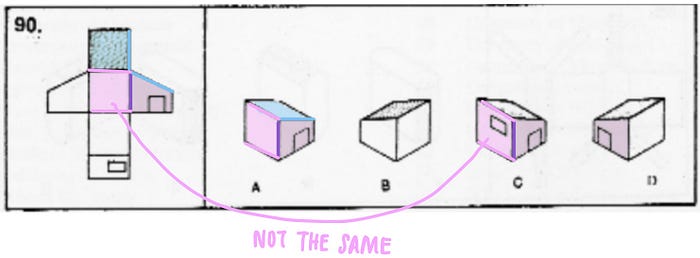PAT Breakdown #5: Become a pattern folding pro
This pre-dental blog is brought to you by Crack the DAT. Crack the DAT offers all the resources you need to ace your Dental Admission Test, all in one place! Try it today: CrackDAT.com
On the Perceptual Ability Test (PAT section) of the Dental Admission Test, you’ll encounter six question types that assess your spatial and visual reasoning skills. One of these question types is pattern folding (also known as 3D form development). Read on to learn all about pattern folding and to learn strategies that will help you master these questions!
What to expect
On the the Dental Admission Test (DAT), you will have a total of 15 pattern folding questions (#76–90 of the PAT section — the last question type you will encounter). You will see a flat (2D) figure. Your goal is to visualize how this 2D figure would fold up to form a 3D figure. Here’s a simple example of what we mean:

Now, if you can imagine it, this 2D pattern would fold up to form the following 3D object:

As you can see, each of the six square faces on the 2D pattern comes together to form a six-sided cube. Sadly, on the real DAT, the figures won’t have different colors, but they nearly always will have unique shading or patterns, and/or be comprised of unusual shapes/pieces. Here’s an example of a real pattern folding question you might see on the DAT:

Pattern folding tends to be one of the trickier question types for test-takers, largely because it requires you to mentally manipulate a 2D object to make it 3D. However, with practice — and with the aid of the strategies below — we assure you that you will be able to master pattern folding. So read on!
The rules
The main rule for pattern folding is that the shapes that are part of the 2D template can’t change when folded up into the 3D object. What do we mean by that? Check out the sample question below:

Let’s start with answer choice A:

Look at the triangle highlighted in pink. Notice that the triangle appears to be a right triangle. Now, look back at the 2D template. Do you see a right triangle anywhere? Nope! Because the 3D shape needs to correspond exactly to its 2D template, we know we can eliminate A.
Moving to answer choice C:

Look at the tiny triangle highlighted in blue. Again, this tiny triangle is nowhere to be found in the 2D template. We can eliminate C on the basis of that alone.
Looking at answer choice D:

Look at the rectangles highlighted in yellow. There are no rectangles anywhere in the 2D template. Answer choice D also has a tiny triangle, which we previously established was also not part of the 2D template. Therefore, we can eliminate D.
That leaves us with B, the correct answer:

We’ve color-coded the shapes so you can see how the 2D template and 3D figure match up. As you can see, even if you can’t perfectly picture how the 2D template would fold up — many people can’t, as this is a very difficult skill that requires a lot of mental manipulation — you can arrive at the correct answer just via process of elimination. Pay close attention to the shapes and patterns you see in the pattern folding section!
The strategies
- Practice makes perfect. It’s true for every PAT question type! With time and practice, you will be able to visualize how the 2D pattern folding templates relate to their corresponding 3D figures. Do practice sets, including the pattern folding practice tests on CrackDAT.com (being sure to pay attention to the explanations for the questions you miss or guess on), and download the CrackDAT app to practice and review in your spare time. You will improve your speed and accuracy as you familiarize yourself with pattern folding, so set aside at least 10–15 minutes each day to practice and learn from your mistakes, and don’t give up!
- Pick a feature/shape to focus on. You are likely to feel overwhelmed if you try to visualize how the entire 2D template folds up to result in a 3D figure. That’s okay! Pick a feature that stands out to you. Let’s illustrate this concept with an example (which will also illustrate the value of process of elimination!)

Let’s just focus on the trapezoid with a square in it (which we’ve colored violet in the image below), and the shapes that surround it, rather than try to make sense of the entire figure.

Looking at answer choice A, the trapezoid (violet) matches up as we would expect with the square to its left in the 2D template (pink). But look at the square above it (blue) — it doesn’t match. In the 2D template, the square is shaded in. In the 3D figure, the square is unshaded. Eliminate A.

Next, let’s look at answer choice C. The trapezoid (violet) looks correct, but the square to its left in the 2D template (pink) does not match. The pink square has an extra little square inside of it. Eliminate C.

Let’s look at answer choice D. Right away, we can see that the trapezoid (violet) is incorrect — it’s essentially a mirror image of the trapezoid in the 2D template. Eliminate D.

Just like that, by focusing on one feature, we arrived at the correct response (answer choice B). If you can’t perfectly visualize how the 2D template might fold up to give the 3D shape in B, that’s more than okay. We’ve color coded it below to help you visualize it, but as you’ve seen, using process of elimination can get you far.

- Familiarize yourself with common question types. There are certain pattern folding question types that are relatively common, like questions involving dice:

It’s worth your while to spend a little bit of extra time being sure that you understand these question types. If online practice isn’t enough, especially if when just starting out, re-create a template like the one above by cutting out a piece of cardstock and drawing numbers/patterns on each face. Then, fold your template into a cube and look at it from all angles, really attempting to understand how the 2D template relates to the 3D figure. For some people, it can be really helpful to use a hands-on approach like this to make the abstract concept in the PAT section feel much more concrete!
- Manage your time. You can budget more time for the pattern folding questions since they require more time than the strictly 2D questions, like angle ranking. But don’t dwell on a question if you’re stumped — just mark it, take your best guess, and move on! Also, remember that speed comes with practice, so don’t be discouraged if you need a lot of time per question at the beginning of your preparation.
With pattern folding, like all PAT question types, practice makes perfect. Remind yourself that your hard work will pay off, and you will notice improvement in time. Let us know if you have any questions in the comments.
Wishing you the best of luck in your PAT preparation!
—
Join the Crack the DAT community, connect with other pre-dental students, and ask questions! Join the Facebook group here.
Crack your Dental Admission Test! Visit our website at CrackDAT.com.
